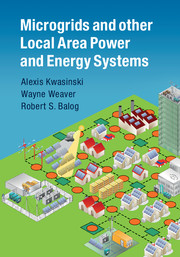7 - System architecture
from Part III - Integration
Published online by Cambridge University Press: 05 July 2016
Summary
This chapter discusses the structure of the interconnected system building blocks that make up a microgrid. These building blocks include the energy sources and storage technologies presented in Chapters 5 and 6, as well as the power electronic interfaces presented in Chapter 4, that typically link these components together into various classes of architectures. The discussion will initially cover various structures for LAPES, including the use of power electronic interfaces to provide more control flexibility. From a planning perspective, LAPES power distribution systems may rely on ac or dc buses. Hence, this chapter also includes a comparison of ac and dc microgrid performance and characteristics. Two key aspects related to LAPES architecture choices are also explored in this chapter: fault detection and behavior of microgrids with constant-power loads.
Microgrid realizations
Radial cabling is, perhaps, the most common approach for power distribution grids. In a radial distribution system, such as the one in Figure 7.1, there is one power path from local generators to each load. Since radial architectures are one of the most common approaches to design power distribution networks in large power grids, microgrids with such an architectural approach can be analyzed somewhat as an extension of conventional power grid distribution systems. One of the advantages of radial distribution systems is that circuit protection schemes are relatively simple to coordinate and design. Two other advantages of radial power distribution systems are that system components’ rating requirements are relatively simple to determine and that voltage drop compensation techniques are easily implementable. However, from a planning perspective, radial systems tend to have limited growing flexibility because load addition or new generation integration may require the installation of new cables or other components unless the originally installed cables and other components were oversized (an additional cost) when they were first installed. One other weakness in radial distribution systems is that the existence of a single power path from each load to the sources makes each power path to a load a single point of failure. Thus, power availability, as seen by each load, may be lower than that observed in equivalent LAPES with another power distribution configuration.
- Type
- Chapter
- Information
- Microgrids and other Local Area Power and Energy Systems , pp. 301 - 336Publisher: Cambridge University PressPrint publication year: 2016



